As heat becomes more extreme, California outlines plan to keep people safe

It may seem unthinkable for Coachella Valley residents who already experience summer days above 120 degrees, but temperatures in California are expected to get even hotter due to climate change.
Daily maximum average temperatures are expected to increase by 4.4 to 5.8 degrees by 2050 and by 5.6 to 8.8 degrees by 2100. The state released an action plan earlier this month that aims to make people aware of the threat to their health, provide community services to help them cope, ensure the climate within buildings is habitable, and use nature-based remedies to alleviate extreme heat.
The Extreme Heat Action Plan will be used to determine how $300 million that was budgeted by the state of California in 2021 will be spent. It also includes a progress report on recommendations made in a 2013 report.
Extreme heat refers to "temperatures that are well above normal conditions," and extreme heat events are "consecutive unusually hot days and nights for a given area," according to the action plan, which notes that different regions of the state experience extreme heat differently.
The plan is an "all-of-government" approach involving a long list of state agencies, and includes eight areas of "near-term focus":
Implementing a statewide public health monitoring system to identify heat illness events early, monitor trends, and track illnesses and deaths.
Cooling schools in heat-vulnerable communities and support for climate smart planning.
Accelerating heat readiness and protection of low-income households and expanding tree canopy in communities most impacted by extreme heat.
Protecting vulnerable populations through increased heat risk-reduction strategies and codes, standards, and regulations.
Building a climate smart workforce through training partnerships and apprenticeships in jobs and careers that address extreme heat.
Increasing public awareness to reduce risks posed by extreme heat.
Supporting local and regional extreme heat action.
Protecting natural systems, including fish and wildlife, from the impacts of extreme heat.
Some of the specific new recommendations include developing model ordinances that local governments could adopt in their building code that would require new construction or building remodels to include ways to reduce heat exposure, such as requirements for air conditioning in top floor living spaces, shade, and insulation.
Another recommendation would establish a system for reporting real-time statewide data on heat-related illnesses during heat waves by monitoring data from hospital emergency departments. This would allow officials to "identify heat illness events early, monitor trends, and track illnesses and deaths, and therefore support officials to respond quickly to minimize health risks from extreme heat events."
Other recommendations include supporting "Community Resilience Centers," which would involve building new facilities or retrofitting existing buildings that could serve as centers for vulnerable residents to avoid the impacts of extreme heat or other events, such as wildfires, power outages, and flooding, and training home health aides to recognize and address early signs of heat-related illness.
There are also several recommendations related to preventing heat illness for workers, including a new Indoor Heat Illness Prevention regulation in development from the Division of Occupational Safety and Health that would require employers to lower indoor temperatures in certain environments.
'Every corner of the state will be impacted'
The recommendations cover a broad swath of life in California — transportation, natural resources, agriculture and business — acknowledging the impact unaddressed extreme heat could have on those sectors.
The Coachella Valley experienced record-breaking high temperatures last summer, with Palm Springs experiencing both its hottest June and hottest July on record. The average temperature recorded at the Palm Springs airport in July 2021 was 97.6 degrees, about 3.6 degrees above the city's average for July.
The temperature in Palm Springs reached 123 degrees on June 17, tying the city's all-time record for the hottest day ever. Temperatures also broke several daily heat records. On Aug. 3, temperatures reached a daily high of 119 degrees, topping the previous record of 118 set in 1995. On June 27, Palm Springs hit 121 degrees, breaking the previous high-temperature record for that day of 120.
Average annual temperature increases across most of California have already exceeded 1 degree, with some areas exceeding 2 degrees, according to the state action plan.
"California’s best climate science projects that every corner of the state will be impacted in years and decades to come by higher average temperatures and more frequent and severe heat waves," the action plan states. "These changes will pose a risk to every region and sector across natural, built, and social systems."
Erin Rode covers the environment for the Desert Sun. Reach her at erin.rode@desertsun.com or on Twitter at @RodeErin.
This article originally appeared on Palm Springs Desert Sun: As temperatures rise, California outlines plan to keep people safe

